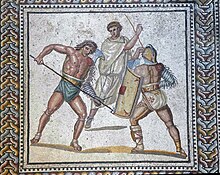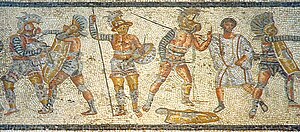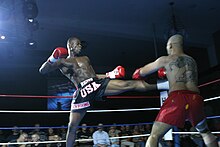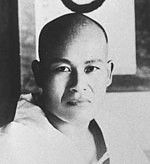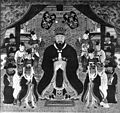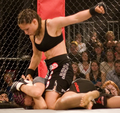The Martial Arts Portal

Martial arts are codified systems and traditions of combat practiced for a number of reasons such as self-defence; military and law enforcement applications; competition; physical, mental, and spiritual development; entertainment; and the preservation of a nation's intangible cultural heritage. ( Full article...)
Although the earliest evidence of martial arts goes back millennia, the true roots are difficult to reconstruct. Inherent patterns of human aggression which inspire practice of mock combat (in particular wrestling) and optimization of serious close combat as cultural universals are doubtlessly inherited from the pre-human stage and were made into an " art" from the earliest emergence of that concept. Indeed, many universals of martial art are fixed by the specifics of human physiology and not dependent on a specific tradition or era.
Specific martial traditions become identifiable in Classical Antiquity, with disciplines such as shuai jiao, Greek wrestling or those described in the Indian epics or the Spring and Autumn Annals of China. ( Full article...)
Selected articles
Selected biography
The son of a landowner from Tanabe, Ueshiba studied a number of martial arts in his youth, and served in the Japanese Army during the Russo-Japanese War. After being discharged in 1907, he moved to Hokkaidō as the head of a pioneer settlement; here he met and studied with Takeda Sōkaku, the headmaster of Daitō-ryū Aiki-jūjutsu. On leaving Hokkaido in 1919, Ueshiba joined the Ōmoto-kyō movement, a Shinto sect, in Ayabe, where he served as a martial arts instructor and opened his first dojo. He accompanied the head of the Ōmoto-kyō group, Onisaburo Deguchi, on an expedition to Mongolia in 1924, where they were captured by Chinese troops and returned to Japan. The following year, he had a profound spiritual experience, stating that, "a golden spirit sprang up from the ground, veiled my body, and changed my body into a golden one." After this experience, his martial arts technique became gentler, with a greater emphasis on the control of ki.
Ueshiba moved to Tokyo in 1926, where he set up what would become the Aikikai Hombu Dojo. By now he was comparatively famous in martial arts circles, and taught at this dojo and others around Japan, including in several military academies. In the aftermath of World War II the Hombu dojo was temporarily closed, but Ueshiba had by this point left Tokyo and retired to Iwama, and he continued training at the dojo he had set up there. From the end of the war until the 1960s, he worked to promote aikido throughout Japan and abroad. He died from liver cancer in 1969.
After Ueshiba's death, aikido continued to be promulgated by his students (many of whom became noted martial artists in their own right). It is now practiced around the world. ( Full article...)
Selected entertainment
" The Fight" is the sixth episode of the second season of the television series The Office and the show's twelfth episode overall. It was written by Gene Stupnitsky and Lee Eisenberg and directed by Ken Kwapis. It originally aired on November 1, 2005, on NBC. "The Fight" guest starred Lance Krall, who played the part of Dwight's sensei, Ira.
The series depicts the everyday lives of office employees in the Scranton, Pennsylvania branch of the fictional Dunder Mifflin Paper Company. In this episode, Michael Scott ( Steve Carell), after being embarrassed by Dwight Schrute's ( Rainn Wilson) superior fighting skills, engages in a karate match with Dwight during lunch. Meanwhile, Jim Halpert's ( John Krasinski) flirting with Pam Beesly ( Jenna Fischer) goes too far.
"The Fight" was known as "Karate" and "The Dojo" by members of the cast and crew due to many of the scenes featuring the titular fight. Several of the cast members of the show—recurring and starring—had martial arts experience. The episode contained several cultural references, with many referring to popular fighting-related movies and television shows. "The Fight" received largely positive reviews from critics. The episode earned a Nielsen rating of 3.9 in the 18–49 demographic and was viewed by 7.9 million viewers.
Sports portals
Selected image
 |
The épée (English: /ˈɛpeɪ/ or /ˈeɪpeɪ/, French pronunciation: [epe]), sometimes spelled epee in English, is the largest and heaviest of the three weapons used in the sport of fencing. The modern épée derives from the 19th-century épée de combat, a weapon which itself derives from the French small sword.
As a thrusting weapon, the épée is similar to a foil (contrasted with a sabre, which is designed for slashing). It has a stiffer blade than a foil. It is triangular in cross-section with a V-shaped groove called a fuller. The épée also has a larger bell guard designed to protect the user’s arm. In addition to the larger “bell” guard and blade, the épée weighs more than the foil and sabre which contributes to its reputation of being the slowest form of fencing. The techniques of use differ, as there are no rules regarding priority and right of way. Thus, immediate counterattacks are a common feature of épée fencing. The entire body is a valid target area. ( Full article...)
General images -
Selected quote
Topics
- Regional origin - China - Europe - India - Indonesia - Japan - Korea - Philippines
- Unarmed techniques - Chokehold - Clinch - Footwork - Elbow strike - Headbutt - Hold - Kick - Knee strike - Joint lock - Punch - Sweep - Takedown - Throw
- Weapons - Archery - Duel - Knife fighting - Melee weapons - Shooting - Stick-fighting - Swordsmanship
- Training - Kata - Practice weapon - Punching bag - Pushing hands - Randori - Sparring
- Striking - Boxing - Capoeira - Karate - Kickboxing - Muay Thai - Lethwei - Sanshou - Savate - Taekwondo - Vovinam
- Internal - Aikido - Aikijutsu - Baguazhang - Tai chi - Xing Yi Quan
- Full contact / Combat sports - Professional boxing - Professional kickboxing - Knockdown karate - Mixed martial arts - Pankration - Submission wrestling
- Self-defense / Combatives - Arnis - Bartitsu - Hapkido - Kajukenbo - Krav Maga - MCMAP - Pencak Silat - Systema - Wing Chun - Legal aspects
- Eclectic / Hybrids - American Kenpo - Chun Kuk Do - Jeet Kune Do - Shooto - Shorinji Kempo - Unifight
Categories
Things you can do
See the list on the right of Martial art related projects who organise work on these articles. You can also add your self to the list of Wikipedians by martial art
Talk page tagging
If you come across a martial arts related article, adding the project template {{ WikiProject Martial arts}} to the talk page will help identify them for improvement and linking to related articles. For Boxing, Fencing, Mixed martial arts and Sumo. Use {{ WikiProject Boxing}}, {{ WikiProject Fencing}}, {{ WikiProject Mixed martial arts}} and {{ WikiProject Sumo}} respectively.
- Assessment
- If possible please assess articles you tag using guidelines ( Boxing, Mixed martial arts and Sumo).
Deletions
Monitor and contribute to deletion debates ( Boxing).
Find images
Wikipedia requested images of martial artists, mixed martial artists and boxers.
Associated Wikimedia
The following Wikimedia Foundation sister projects provide more on this subject:
-
Commons
Free media repository -
Wikibooks
Free textbooks and manuals -
Wikidata
Free knowledge base -
Wikinews
Free-content news -
Wikiquote
Collection of quotations -
Wikisource
Free-content library -
Wikiversity
Free learning tools -
Wikivoyage
Free travel guide -
Wiktionary
Dictionary and thesaurus
![Image 1 Rhee Taekwon-Do (Korean: 리태권도; Hanja: 李跆拳道), also known as Rhee Tae Kwon-Do, Rhee Tae Kwon Do, or Rhee Taekwondo,[a] is a martial art school in Australia[b] teaching the Korean martial art of taekwondo. Its full name is "Rhee International Taekwon-Do (Australia)". Chong Chul Rhee, one of the original masters of taekwondo, founded the school in the mid-1960s. Two of Rhee's brothers, Chong Hyup Rhee and Chong Yoon Rhee, later came to assist him in the 1970s. C. C. Rhee claims the title 'Father of Australian Taekwondo' and Rhee Taekwon-Do is widely publicised as being Australia's first and biggest taekwondo school. It has at least 294 publicly listed dojang (training halls) in Australia, with perhaps around 1,400 dojang in total at its peak. Several Australian martial art school founders received their foundational taekwondo training in Rhee's school. (Full article...)](https://upload.wikimedia.org/wikipedia/en/d/d2/Blank.png)

